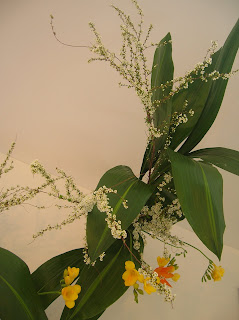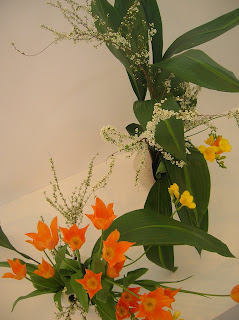The DMZ
Our one daytrip outside of Seoul was to the DMZ, or the De-Militarized Zone, separating North and South Korea. It is a bit of an ironic name, I think, as there are more military personnel surrounding the DMZ than anywhere else in Korea, I suspect, but within the four km wide, 260 km long section there are none. The tour started out by visiting Memorial Altar, the furthest north point that Korean citizens are allowed to go to. This is a memorial for people to honour and pray for their family members that are on the other side of the border. The prayers are symbolised by yellow ribbons which are tied to trees around the area. Next we passed through the military checkpoint, as Korean citizens can not go this far, and visited the Third Tunnel, a tunnel the North Koreans began digging towards Seoul. The tunnel is actually 400m past the DMZ, but we were only able to go through about 250m of it. We then proceeded to an observatory where we could watch North Korea. From what we could see the two km of North Korean DMZ looked identical to the 2 km of South Korean DMZ, but apparently they have a bigger flag. From here it was onto Dora Station, famous because it was visited by George Bush when it was opened. This is a train station for the train that will "soon" be running between North and South Korea. All in all, it was a pretty interesting trip. On the drive up, upon leaving Seoul, the highway was surrounded by barbed wire and soldiers in watch towers. Soldiers were on guard everywhere, and most places we were not allowed to take pictures (so you must excuse the scarcity of them here). There seems to be high hopes of re-unification in Korea, but with the knowledge that the likelihood of it happenning may be the same as of it not happenning anytime soon.

The Observatory.

Memorial Altar

The Yellow Ribbons

The Barbed Wire

Zach and I on the Bridge of Freedom, the route home for hundreds of POWs following the Korean War, that has now been closed.
More from Gyeongbokgeung
Here are a few of us from Gyeongbokgeung.
 In an archway on the palace grounds.
In an archway on the palace grounds.  Jane.
Jane.  A classic "long-arm" shot in front of the main hall and throne room.
A classic "long-arm" shot in front of the main hall and throne room.  Jane at the National Folk Museum. Why is she so excited? That's an ancient potato storage vessel, who wouldn't be?
Jane at the National Folk Museum. Why is she so excited? That's an ancient potato storage vessel, who wouldn't be?
Gyeongbokgung
Gyeongbokgung is the largest palace in Seoul and served as the primary palace of the Joseon dynasty until it was burned down in 1592. Eventually rebuilt, it has some impressive sights. Two-storied Gyeonghoeru pavillion, with its 48 columns, overlooks a pond on the palace grounds. The palace itself is surrounded by forested mountains, right in the middle of the city.
 The palace's main gate with mountains in the background.
The palace's main gate with mountains in the background.  A building on the palace grounds.
A building on the palace grounds.  Gyeonghoeru pavilion overlooking a pond.
Gyeonghoeru pavilion overlooking a pond.  Rows upon rows of columns surround the main courtyard.
Rows upon rows of columns surround the main courtyard.  A detail of the palace's main gate.
A detail of the palace's main gate. Also in the palace grounds is the National Folk Museum of Korea, which has an impressive display of the material culture of Korea dating from before the Joseon dynasty to modern times.
 A pavilion which sits atop the museum.
A pavilion which sits atop the museum.  Replicas of pre-Joseon era statues on the museum's grounds.
Replicas of pre-Joseon era statues on the museum's grounds.
More from Changdeokgung
Here are a few of us from Changdeokgung.
 Jane and I in Biwon (the Secret Garden)
Jane and I in Biwon (the Secret Garden)  In the palace grounds.
In the palace grounds.  Another one in the palace grounds.
Another one in the palace grounds.  In the garden, standing by an arch. Those who pass under it are supposed to live forever. It was built to bless the Joseon kings.
In the garden, standing by an arch. Those who pass under it are supposed to live forever. It was built to bless the Joseon kings.
Korean Food
Before we left, one of the things for which we were most excited was Korean food. Not to say that the culinary selection in Japan is lacking (you all know how much we love Japanese food); however, to find something even a little spicy is a bit of an ordeal here in Kanazawa. This was certainly not the case in Korea. Mounds of kimchi are served with every meal, and red pepper paste is always in abundance. What is more, food was everywhere. Markets had stall after stall selling green onion cakes, skewered meat of all kinds (see the corn dog below), fresh fruit juice and silk worm larvae (!). Needless to say, it was great!
 Jane with her bibimba...
Jane with her bibimba...  ...and Zach with his.
...and Zach with his.  Check out this monstrosity. Imagine a corn dog. Now take that corn dog and add another layer of batter. Then dip that batter in a bunch of french fries and deep fry the whole thing. Add ketchup and voila! Heart attack on a stick.
Check out this monstrosity. Imagine a corn dog. Now take that corn dog and add another layer of batter. Then dip that batter in a bunch of french fries and deep fry the whole thing. Add ketchup and voila! Heart attack on a stick.  Last but not least... a steaming vat of silkworm larvae. Delicious!
Last but not least... a steaming vat of silkworm larvae. Delicious!
Deoksugung
As I said in the previous post, Seoul is teeming with people. It turns out the city is also teeming with old palaces. Before it became the capital of the Republic of Korea, Seoul was the capital of the Joseon dynasty, which ruled the Korean peninsula for more than five hundred years (1392-1910). Even before that, it had been the capital of other states on the peninsula and has a history stretching back to at least 18 BCE. WIth such an ancient history, the city is full of wonderful old sites, so many of which have survived the passage of time. However, being that Korea is set neatly between two rather imperialistic nations (Japan and China) a number of buildings from the Joseon dynasty have been burned down and reconstructed (some more than once). The following pictures are from Deoksugung, which was originally the residence of a Joseon prince but became Seoul's primary palace in 1593 after the Japanese destroyed all the others in the city during their 1592 invasion. Not all the buildings on this site date from that time, of course (many were reconstructed or restored in the early 1900s).
 Guards in traditional dress standing in front of the main gate at Deoksugung.
Guards in traditional dress standing in front of the main gate at Deoksugung.  The main hall at Deoksugung.
The main hall at Deoksugung.  In the palace garden.
In the palace garden.  A statue of King Sejong, one of the greatest kings of the Joseon dynasty. He is credited with the invention of the Hangeul script, an almost perfect description of Korean phonetics. Quite an impressive feat!
A statue of King Sejong, one of the greatest kings of the Joseon dynasty. He is credited with the invention of the Hangeul script, an almost perfect description of Korean phonetics. Quite an impressive feat!  The Two Wise Men of Korea (or so says Jane).
The Two Wise Men of Korea (or so says Jane).
Bright Lights, Big City!
With a population of over 10 million, Seoul is among the world's largest cities. This means lots of crowding and lots of buildings. As in Tokyo, most of the urban architecture is functionalist. It is not the prettiest city when viewed from a distance, but, as you will see, beauty can be found. For now, though, here are some pictures of Seoul looking the part of a teeming metropolis.
 The Samsung building.
The Samsung building.  Seoul City Hall
Seoul City Hall  A small alleyway looking onto a building in the distance.
A small alleyway looking onto a building in the distance.  The 63 Building, Seoul's tallest. The picture was taken during our cruise down the Han River.
The 63 Building, Seoul's tallest. The picture was taken during our cruise down the Han River.  From a park right near our hotel, another impressive tower.
From a park right near our hotel, another impressive tower.
Korea
This past week, we took a brief trip to Korea. We only had a few days, so we spent most of our time in Seoul. The next few posts will have pictures from all the places we visited.
 A view from the plane.
A view from the plane.  Our first glimpse of Korean soil.
Our first glimpse of Korean soil.  Touchdown!
Touchdown!  Bright lights, big city! Our first view of Seoul.
Bright lights, big city! Our first view of Seoul.  Our first true Korean food: unidentified meat on a stick.
Our first true Korean food: unidentified meat on a stick. Labels: Korea, Seoul, Travel
Ikebana Show!!!!!





This week Alexis and I had an arrangement in my first ever ikebana show!! We made one arrangement that consisted of two parts. Alexis' is the flowery part, and mine is the leafy part (thus, none of the fear of making it alone, but all the glory of still having our own parts!) Yesterday we went to see it, and it was really great as a lot of our friends came with us, which was really, really sweet of them (because who really wants to spend their holiday looking at lots of flowers?) I think the show was a success!!



















































